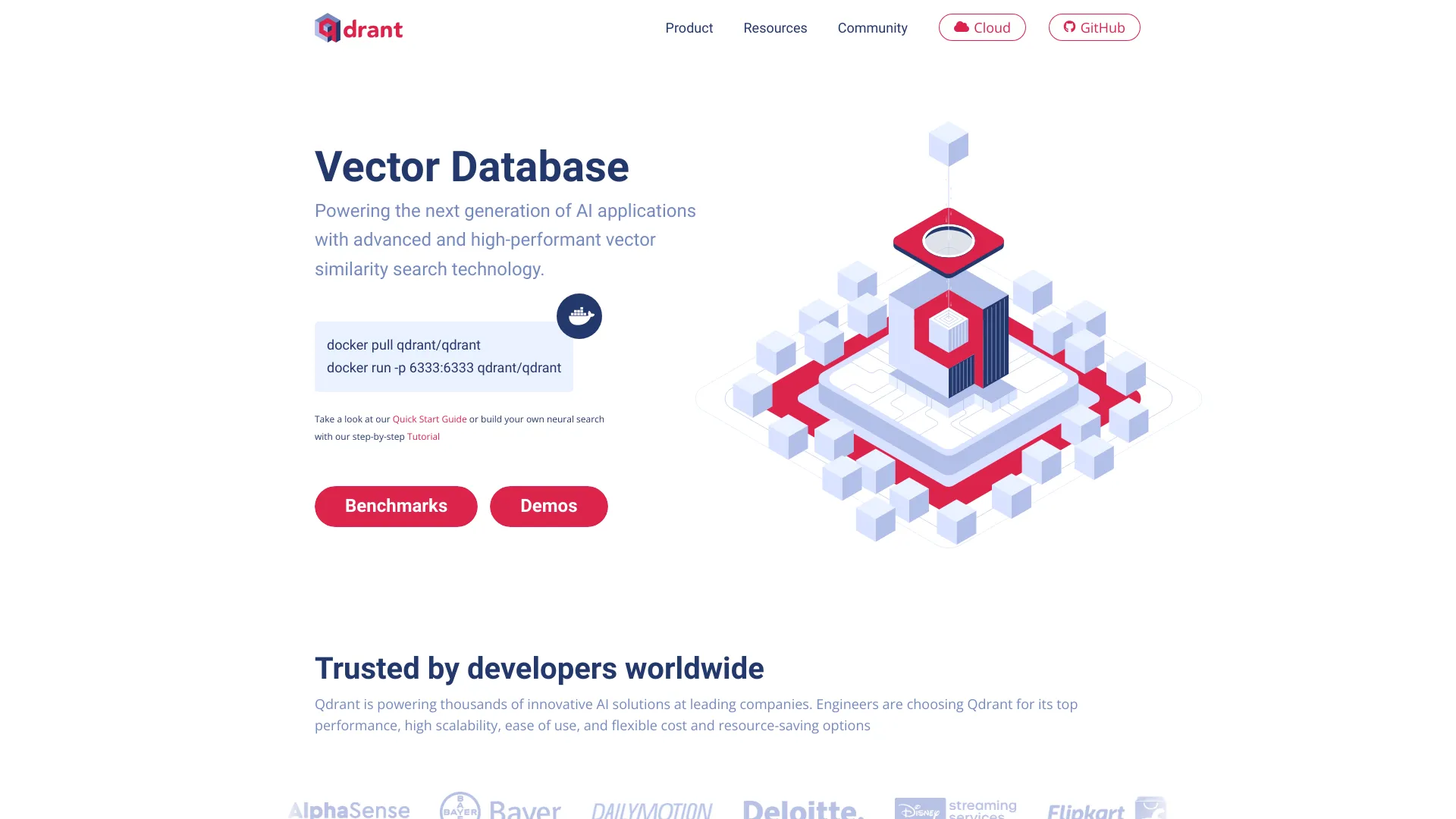
Qdrant
Open Website-
Tool Introduction:Rust-powered vector DB for scalable similarity search + rerank.
-
Inclusion Date:Oct 28, 2025
-
Social Media & Email:
Tool Information
What is Qdrant AI
Qdrant AI is an open-source vector database and vector search engine built in Rust. It delivers low-latency, scalable similarity search over embeddings via simple REST and gRPC APIs. By storing high-dimensional vectors alongside rich metadata and filters, Qdrant powers semantic search, recommendation, and retrieval-augmented generation (RAG). With features like a Score Boosting Reranker and hybrid search, it combines vector relevance with business logic to help teams ship production-grade discovery, matching, and personalization.
Qdrant AI Main Features
- High-performance vector indexing: Optimized HNSW-based indexing for fast approximate nearest neighbor search on large, high-dimensional datasets.
- Hybrid search with filters: Combine vector similarity with structured payload filtering to apply facets, categories, permissions, and business rules.
- Score Boosting Reranker: Blend vector scores with custom signals to refine results for relevance and business objectives.
- Flexible collections and payloads: Store vectors with rich metadata, define distance metrics, and tune index parameters per collection.
- Scalability and resilience: Horizontal sharding and replication options support high availability and growing workloads.
- Developer-friendly APIs: Simple REST and gRPC endpoints with official clients and integrations for Python, JavaScript, and popular AI frameworks.
- Ecosystem integrations: Works with leading embeddings providers and toolkits to turn encoders into production applications.
- Operational tooling: Snapshots and backup capabilities to protect data and simplify maintenance.
Who Should Use Qdrant AI
Qdrant AI suits ML engineers, data scientists, and platform teams building semantic search, recommendation systems, and RAG pipelines. It is a strong fit for product search in e-commerce, content discovery in media, retrieval for chatbots and assistants, similarity matching for deduplication, and anomaly or intent detection use cases where vector embeddings and metadata filters are essential.
How to Use Qdrant AI
- Deploy Qdrant via Docker, Kubernetes, or a managed cloud service.
- Create a collection by specifying vector size and a distance metric (e.g., cosine, dot, Euclidean); define payload fields as needed.
- Generate embeddings using your chosen model (e.g., OpenAI, Hugging Face, Cohere) and upsert vectors with metadata through the REST or gRPC API.
- Run vector searches with top-k, apply structured filters for hybrid results, and optionally use the Score Boosting Reranker.
- Tune index parameters and scaling options; manage snapshots/backups to maintain reliability.
Qdrant AI Industry Use Cases
E-commerce teams build semantic product search and personalized recommendations. Support and documentation teams enable RAG over manuals and knowledge bases. Media platforms power content discovery, near-duplicate detection, and creator matching. Security and fraud teams use vector similarity to group related events and surface anomalies for investigation.
Qdrant AI Pricing
Qdrant AI is open-source and can be self-hosted at no license cost. A managed cloud offering is available with tiered, usage-based plans. For the latest details on resources, limits, and any free tiers or trials, refer to the official pricing page.
Qdrant AI Pros and Cons
Pros:
- Open-source performance in Rust with low latency and strong throughput.
- Hybrid search that combines vector similarity with rich metadata filtering.
- Clear REST/gRPC APIs and broad ecosystem integrations.
- Production features such as replication options, snapshots, and backups.
- Score Boosting Reranker to align relevance with business signals.
Cons:
- Requires external models to generate embeddings prior to indexing.
- Operating and tuning at scale (index params, memory, shards) adds complexity.
- Not a full relational database; complex transactional logic may require additional systems.
- Index building and vector storage can be resource intensive for very large corpora.
Qdrant AI FAQs
-
How is Qdrant AI different from libraries like FAISS?
Qdrant is a full vector database with storage, indexing, filtering, APIs, and operational features, while FAISS is an indexing library that you embed into your own systems.
-
Does Qdrant AI support hybrid search?
Yes. You can filter by structured payload fields and combine those constraints with vector similarity to control relevance and access.
-
Which distance metrics are supported?
Common metrics include cosine similarity, dot product, and Euclidean distance, selectable per collection.
-
Can I use Qdrant AI for RAG?
Yes. Qdrant integrates with popular frameworks to store embeddings for passages and fetch top-k context for retrieval-augmented generation pipelines.
-
How do I deploy and scale Qdrant AI?
Start with Docker or a managed cloud deployment, then scale horizontally with shards and replication. Tune index parameters to meet latency and recall goals.

